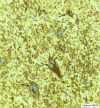Primary Leiomyosarcoma of the Pancreas-a Case Report and a Comprehensive Review
- PMID: 27631424
- PMCID: PMC5138273
- DOI: 10.1007/s12029-016-9872-y
Primary Leiomyosarcoma of the Pancreas-a Case Report and a Comprehensive Review
Abstract
Purpose: Primary mesenchymal tumors of the pancreas are rare, with leiomyosarcomas the most encountered entities among the pancreatic sarcomas. With few exceptions, single case reports published over the last six decades constitute the entire scientific literature on this topic. Thus, evidence regarding clinical decision-making is scant.
Methods: Based on a case report and an extensive literature search in PubMed, we discuss the clinical aspects and current management of this rare malignancy.
Results: We identified only two papers with more than a single case presentation; these institutional patient series were limited to five and nine patients. Additionally, a few papers sought to summarize the individual case reports published in the English and/or Chinese language. The clinical presentation is rather non-specific. Moreover, modern imaging modalities are insufficiently accurate to diagnose leiomyosarcoma of the pancreas. Treatment goals include a complete resection with free margins. Proper morphologic examination using immunohistochemistry and the application of a grading system are clinically important for prognostication. The efficacy of adjuvant treatments has not been established.
Conclusion: Primary pancreatic leiomyosarcoma is extremely rare, and the scientific literature is primarily based on single case reports. Conclusions on management and prognosis should be drawn with caution. A multidisciplinary team consultation is warranted to discuss a thorough individual treatment plan based on the available scientific literature, despite its low evidence level.
Keywords: Leiomyosarcoma; Mesenchymal tumor; Pancreas; Review.
Conflict of interest statement
Compliance with Ethical Standards Funding None. Conflict of Interest The authors declare that they have no conflict of interest.
Figures






References
-
- Miettinen M, Fletcher CD, Kindblom LG, et al. Mesenchymal tumors of the pancreas. In: Bosman F, Carneiro F, Hruban RH, Theise ND, et al., editors. WHO classification of tumours of the digestive system. 4th. Lyon, France: International Agency for Research on Cancer; 2010. p. 331.
Publication types
MeSH terms
LinkOut - more resources
Full Text Sources
Other Literature Sources
Medical
